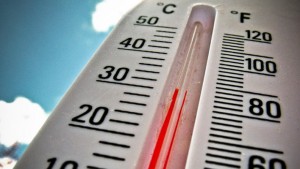In a previous post titled “Turning Up the Heat on Tropical Saltwater Aquariums,” I explained that it’s important to maintain a stable water temperature somewhere in the range of 76° and 80°F in marine tanks, and that using a quality submersible heater will help prevent the temperature from dropping below that range.
But what about the opposite extreme? What about preventing the water temperature from climbing too high and stressing the inhabitants in a tropical marine tank? Do you need to buy an aquarium chiller for that purpose? Well, the answer to that question is “possibly.”
Here are some factors to consider in determining whether a chiller might be a sound investment for you and your saltwater critters:
Summer highs in your area
Summers here in Toledo, Ohio can be stiflingly hot, and it’s not unusual for the temperature to fluctuate by many degrees in a relatively short period—75°F one day, 95° the next, and 103° the following Sunday. If you live in an area that’s subject to similar scorching temps in summer or all year round, your marine livestock can really take a beating depending on how your home is cooled—which brings us to…
Whether your home has AC
Having central air conditioning in your home, or even a window air conditioner to cool the room that houses the aquarium, can eliminate the need to invest in a chiller. But keep in mind that you can’t be too stingy with the cool air. If you’re the type who waits until it gets intolerably hot in the house before “pulling the trigger” on the AC, your fish and/or invertebrates will be subjected to a water temperature spike followed by a rapid cool-down each time—especially if you have a smaller system. Remember, the goal is to maintain a stable temperature within the correct range, not to bounce around a specific value.
The location of your aquarium
The specific location of the tank in your home can influence whether a chiller is necessary as well. For instance, if it’s set up in a relatively well-insulated basement that doesn’t tend to warm rapidly in response to spiking outdoor air temps, you may be okay without a chiller. On the other hand, you may need one if the tank is located in a stuffy, humid upper-story bedroom or office.
Lights and pumps
Lights are among the biggest influencers of aquarium water temperature—especially high-intensity reef-lighting systems that include metal halide lamps, which tend to run much hotter than LEDs and fluorescent tubes. Of course, submersible water pumps, also impart some heat to the water. Depending on other factors, evaporative cooling in the form of a fan blowing across the top of the aquarium may suffice to keep the water temperature from spiking when the lights are on. If not, a chiller may be in order.
Who’s chillin’ out there?
So, fellow salties, are you chillin’? If so, what prompted you to make the investment in an aquarium chiller?



